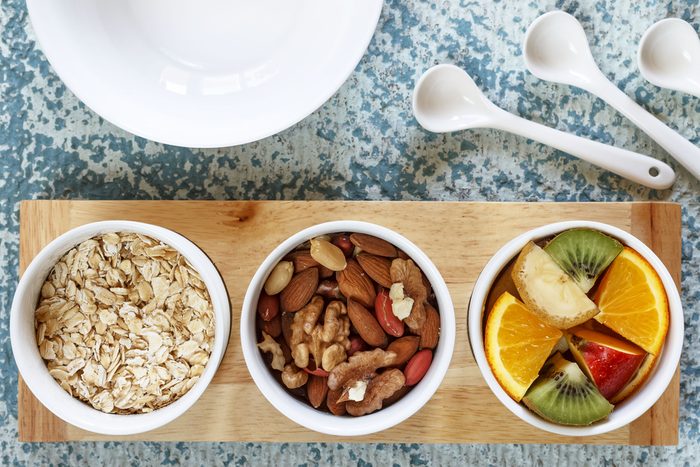
1. Eat Regularly
“Skipping meals can have a negative impact on your metabolism,” says Toronto nutritionist Aviva Allen-your body might start storing extra fat in anticipation of more missed meals. Instead of eating less, consume small, nutrient-dense snacks and meals more often, every three hours is ideal, and try not to eat after seven o’clock at night, when your metabolism is at its slowest.

2. Reduce Your Portions
It’s a simple fact: Eat less and you’ll lose weight. There’s good evidence that over the past 50 years, restaurant portions have “super-sized,” and our waistlines have grown along with them. We’ve become accustomed to eating larger servings to the detriment of our health.
To combat this habit, use a smaller plate for your meals. Less space on the plate means automatic portion control. And when ordering or buying food, choose the smallest size of any high-calorie items.

3. Ditch The Crash Diet
Dieting makes food an enemy, not a source of sustenance and well-being. So-called yo-yo dieting-losing weight, putting it back on, losing it again and so on-is bad for your health. If you suddenly reduce your food intake, your body, because it is designed for survival, will slow down your metabolic rate in order to store energy more efficiently. This is why people on a diet crave snacks like chocolate, which gives a quick boost to their energy levels, and why weight loss slows down dramatically after the first couple of weeks.

4. Don’t Rush Your Meals
Eat slowly. It can take half an hour for the brain to realize the stomach is full so don’t rush your meals. It’s a principal reason we overeat. Always put your fork down between mouthfuls.

5. Give Your Kitchen A Makeover
Take a look in your fridge-what do you see? Two jars of mayonnaise, some leftover cheddar and a lot of sugar-laden condiments in jars? Now open the cupboards: what’s the cookie and cracker situation? Do an honest evaluation of what you tend to keep on hand. If you always have chips on hand, you will eat them. If you keep Goldfish crackers around “for the kids,” you can be sure that they won’t be the only ones snacking on them. Throw out anything that’s going to be a temptation and sidetrack you from your weight-loss goals. Be ruthless. Give the unopened food items and cans to your local food community centre.

6. Watch Your Calories, Even If You Exercise
There are not enough hours in the day that will allow you to exercise off a Happy Meal,” says Dr. Arya Sharma, chair for Cardiovascular Obesity Research and Management at the University of Alberta.
Working out has countless benefits to your health and will help keep your weight down by building muscle and encouraging better body image, but when it comes to shedding pounds and keeping them off, reducing your caloric intake is the way to go, Sharma adds.
If counting calories make you cringe, Jessica Begg, a registered dietitian based in Vancouver, has this advice: “As corny as it is, you really can’t go wrong with Canada’s Food Guide. I would rather people look at recommended portion sizes than calories.”
To keep weight down, she suggests that 80 percent of your daily calories come from foods recommended by the Food Guide. That leaves the other 20 for treats such as cookies, chips, and cocktails. “[It’s] the equivalent of a small dessert every day,” she says.

7. Understand Why You Overeat
Looking back, can you see what lead you to overeat in the past? It’s important to understand if you turn to food when you’re stressed or want comfort.
Sometimes the triggers for overeating can be linked to hormones. For example, the hormonal changes of PMS can make women crave sweet or salty foods. Another factor could be your mood. “A typical example is depression,” says Dr. David Lau, president of Obesity Canada. “When people are depressed, they may become physically inactive. And when they’re down, they turn to something that will make them feel better, often foods that can be addictive.”
